AS SEEN IN





Home » Filming bandita the stoat for tv | behind the scenes | tracking down a stoat star
Bandita is the star of a TV documentary about the little-understood weasel animal family. A beautiful female stoat, mustela erminea, she lives in my garden in Yorkshire, in the north of England, and was filmed two years ago as she raised a litter of five kits here. Stoats are one of the most elusive of mammals and it took more than 50 surveillance cameras, considerable field skills and a lot of luck to be able to follow her as she faced daily challenges to protect her young.
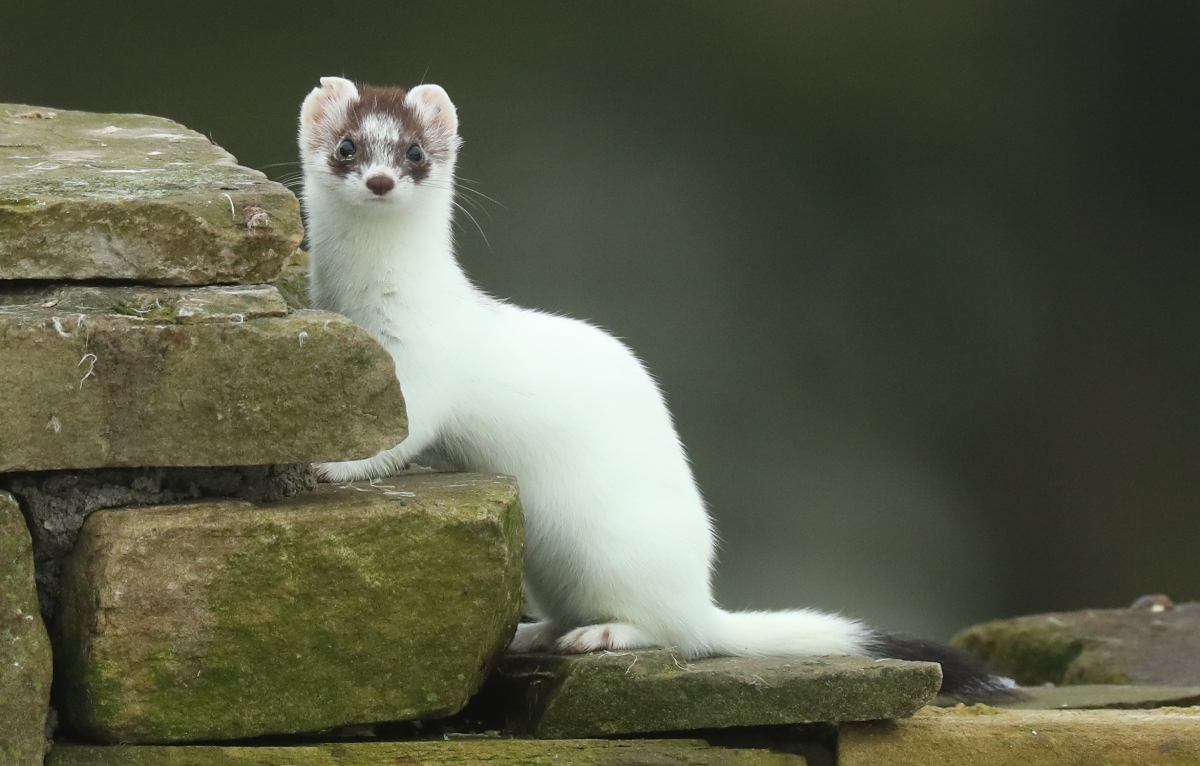
For US readers: In my blogs, a weasel refers to your ‘least weasel’ and stoat is your ‘short-tailed weasel’. For more on ID and definitions: CLICK HERE
I first noticed Bandita in my garden in the winter of 2017. She was pure white except for a band of brown around her eyes that made her look as though she was wearing a mask and so I named her Bandita in reference to this mask. But it wasn’t until later in the year, when her white coat moulted back to its usual chestnut brown, that I realised Bandita had actually been born here in the garden in 2016. I had originally named her ‘Tash, due to a distinguishing mark under her nose, and she belonged to a family of stoats whose lives I had been following in my garden for years.
Click here to read more on how the weasel watch project began.
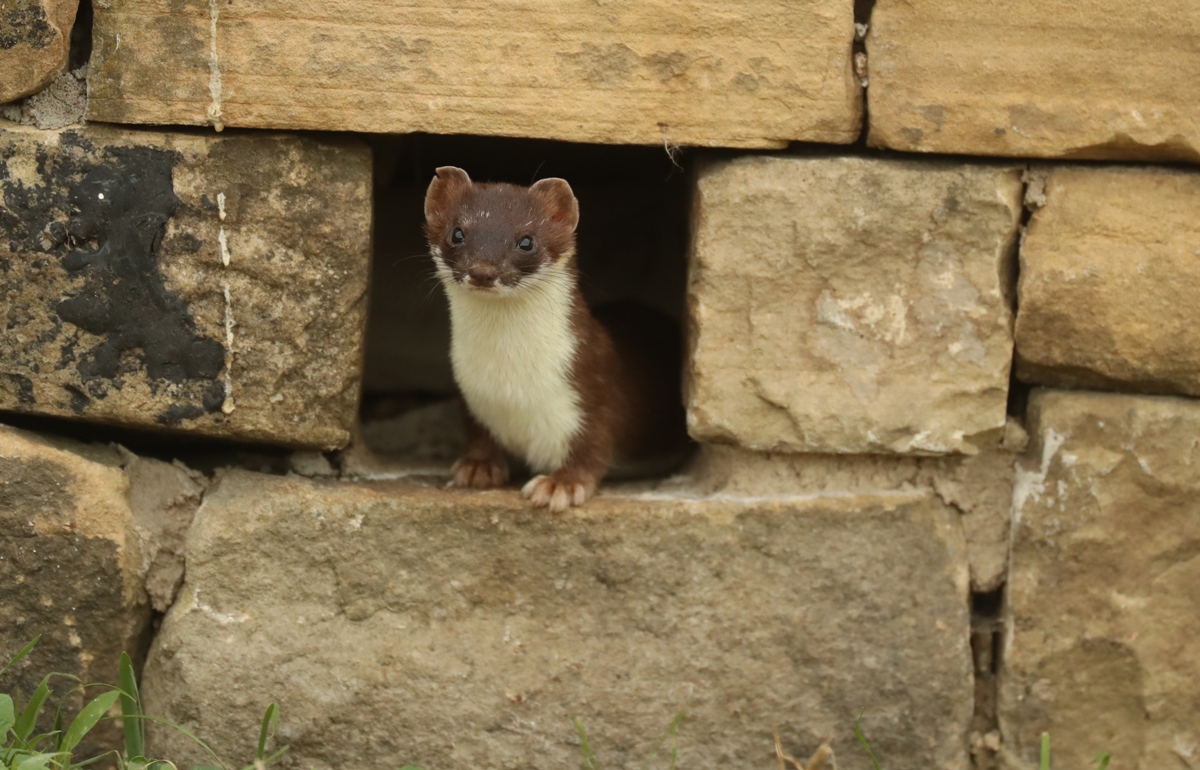

By spring I realised that Bandita was pregnant and so I stepped up my surveillance of her in the hope that she would give birth in the garden where I could watch the kits grow up. I have adapted a section of my garden into a perfect habitat for stoats and in this ‘Stoat City’ are a number of bespoke nest boxes and feeding chambers, all rigged with surveillance cameras that relay images back to my art studio so that I can watch what happens 24/7.
Click here to read about how I built a ‘stoat city’ in order to film stoats in my garden.
On April 7, Bandita’s swollen belly changed shape so that it now hung low in her body. This was a sure sign that the young were engaged in her pelvis and I stepped up my surveillance even further. But then quite suddenly Bandita disappeared from sight for two days and despite running through hours of footage, there was no sign of her presence anywhere. When she eventually re-emerged she was much slimmer and was also clearly hungry. I realised, as she searched frantically for food, that she must have given birth somewhere out of sight of the cameras.
I was disappointed that Bandita hadn’t chosen to give birth in one of my specially designed nests, but I wasn’t surprised. It would have been too much to expect her to choose to nest in an artificial chamber that would still smell strongly of humans. I was, at least, relieved that she had given birth somewhere close by. But now I had to find her new nest and this proved one of the most challenging tasks. It took me five weeks to locate it using eight trail cameras and a network of static surveillance cameras to plot her movements. I became so frustrated as I couldn’t seem to get any conclusive data. I decided to move all eight trail cameras in and around my vegetable patch in the front garden where she was taking food every night in order to get a direction to work from. I was very surprised when the cameras showed her heading straight towards my house with the food.
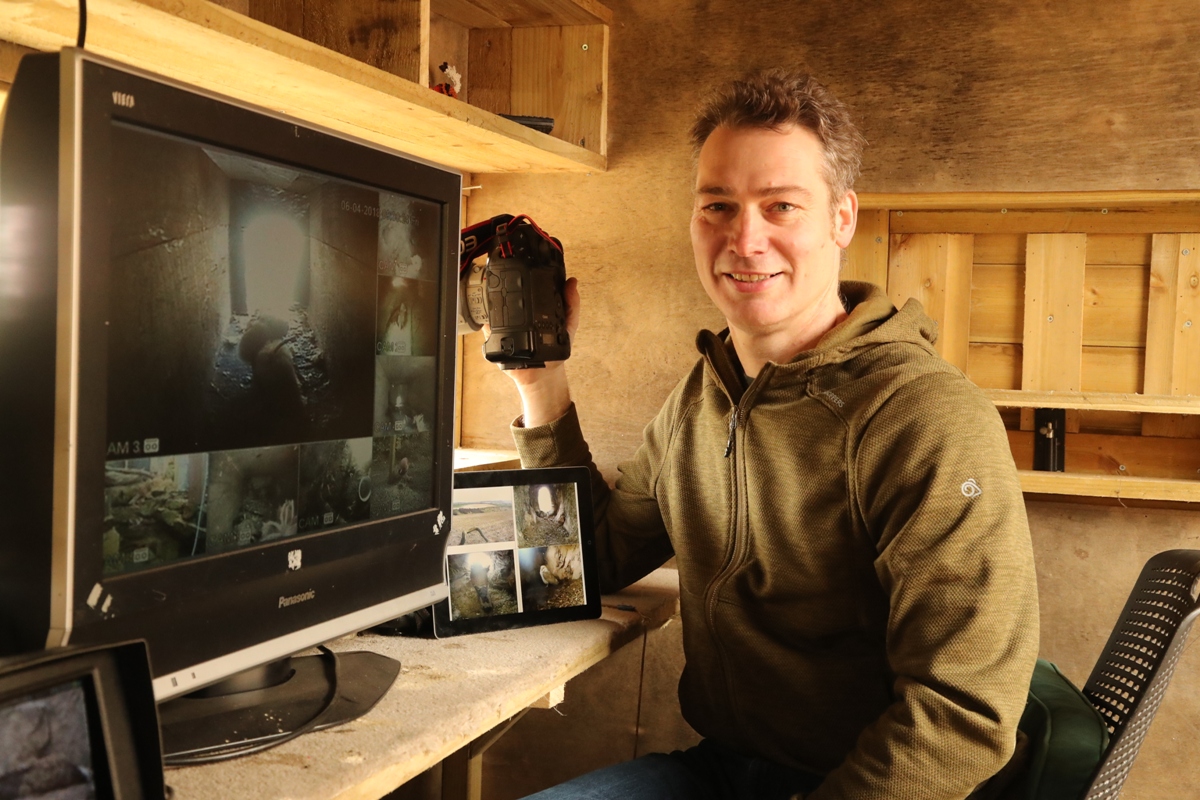

The following night I relocated all the cameras to pick up her trail from this point. I know every nook and cranny in the garden and had a hunch that an old rat hole in a shrub border near the pond might be a likely hidey-hole for a stoat with kits. I placed a camera near it and checked it the following morning. Bingo. I had found her. After all that searching she was just five metres from the living room. I admired her for being so crafty, nesting right under our noses, but I expect she felt safest here.I spent the rest of the day trying to deploy cameras around her new home without disturbing her. It is a complex process in the best of circumstances, but with deep vegetation all around it was even more difficult to get a good view. I also had to get a mains power supply and camera cables in place. However, in spite of these challenges, I eventually succeeded.
I watched the cameras intently that evening. I had put some food out for her close by to distract her from the newly installed cameras and at midnight she came out and dragged the food and some nesting material down the hole. I watched the entrance to the hole to see if she returned.She didn’t and so I eventually went to bed. By now it was 1.30am, but despite the lateness, I was so excited at the thought that my new camera set up might actually work that I couldn’t sleep. At 4am I went down to check the cameras. Bandita was up and was dragging more nesting material down the hole in to the nest. I went back to sleep thinking I had cracked it.
But then when I checked the cameras the next morning I discovered that only 15 minutes after I had seen her take nesting material into the hole, she had moved the kits out of the nest, one by one. I watched the screens as she carried the kits in her mouth, grasping each one by the scruff of its neck. There were five in all. The only good news for me was that Bandita only took one minute between each trip, which meant that her new nest was just 30 seconds away. Using past experience, and having timed the speed that a stoat runs, I knew she had to be around 30 metres away.
I soon realised why she had moved so suddenly. A replay of the cameras outside the nest showed that a large male stoat had tried to enter Bandita’s nest. There was also footage of a huge rat lurking dangerously close to her young family. I imagine too that the activity installing my new cameras didn’t help.
So now I concentrated on finding the location of the new nest. I began by checking all of my bespoke stoat nest boxes, hoping that she might have moved there. But these all turned out to be empty. Then the following night my trail cameras picked Bandita up on a gabion wall that marks the boundary to my garden. This location is just five metres from the entrance to one of my purpose-built nests. I had trained the cameras there following a hunch and was delighted that she was now so close to where I wanted her. This nest was made from a large wheelie bin sunk into the ground and had hidden cameras and a microphone inside. I began leaving food out for her in and around a pipe that led to this bin-nest, but instead of choosing this especially-adapted nest box, where we would be able to film her, she opted to make her own nest inside the gabion wall, tunnelling vertically into the wall via a small gap in the mesh at the top of the wall.
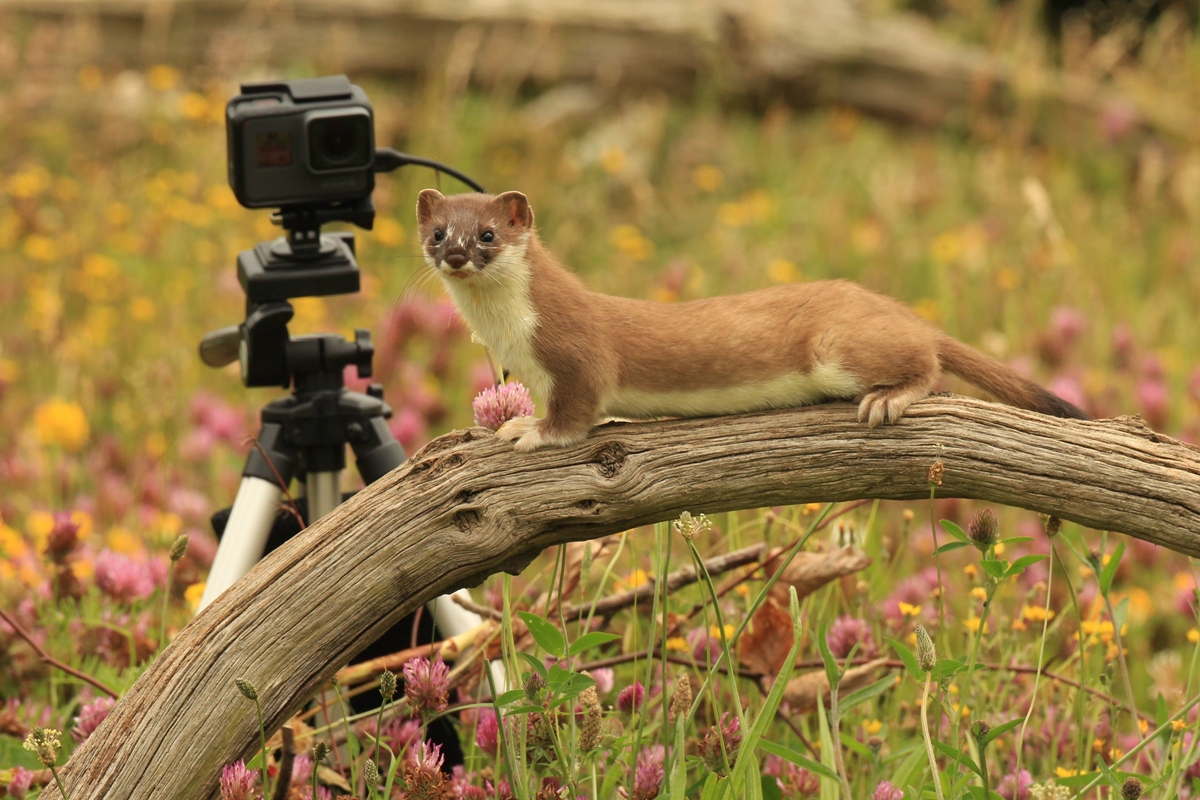
There then followed a dramatic turn of events after the cameras picked up a large male rat trying to enter Bandita’s new nest. Bandita and the rat lunged back and forth at one another. Although this made for dramatic film footage, I was relieved when the rat gave up. She seemed to relax a little after this and when I noticed her go close to the entrance to my bin-nest I began to hope she may use it. But then, worryingly, I checked the cameras and in the bin-nest was a large rat. This was a disaster. My job of encouraging Bandita to use my bespoke nest now seemed impossible.
Thankfully I had designed the nest to cope with situations like this. It is possible to block off both pipes leading to the nest and so I blocked off one of the pipes and then placed a live rat trap at the end of the other. This worked to plan and the rat was subsequently dispatched. The only problem was that now the nest smelled strongly of rat.
At this point, the cameras picked up a new stoat in the garden. It was a large male and it was clearly trying to get Bandita’s attention since it would sniff about at the entrance to the nest several times a day. This stoat was a newcomer to the valley and I named him Brad. Brad’s timorous manner suggested his attentions were amorous rather than aggressive. Bandita, however, was very cautious of his approaches. She would not let him near the nest. But then one day I was close enough to get a good view of the two of them out on the road that leads to the house. Out there she was much more receptive to his advances. I could hear her chittering and whickering as she ran alongside him and I became convinced that her responses to his attention were flirtatious. By now it was May and I realised she must have come back in to season.
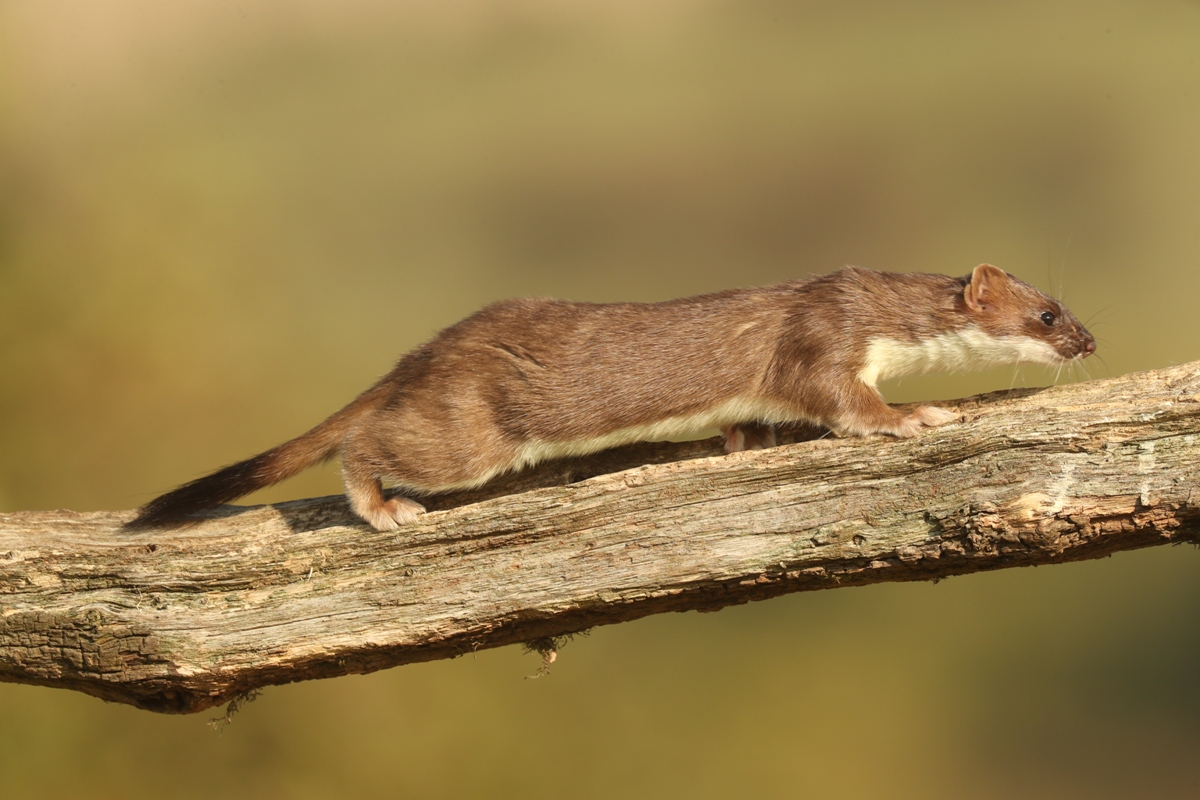
It is actually quite common for a female to become receptive to mating shortly after giving birth and males are also known to mate female kits in the nest, even when these youngsters are still blind and helpless. This extraordinary behaviour may seem unpalatable to us, but female stoats are able to delay implantation of their eggs which means the kits leave the nest ready to give birth the following year. The adult female also delays implantation, meaning that a male stoat that mates with both mother and kits ensures his line continues well into the next breeding season. This explained the male’s interest in Bandita’s nest. I realised that it was only a matter of time before Bandita eventually succumbed to the male’s charms and allowed him to enter the nest for several minutes. It was frustrating for us not to have a camera in the nest to capture this extraordinary behaviour.
Exactly 10 days later, at 9.15am on May 31st, the moment I had been waiting for arrived. Bandita appeared on top of the gabion wall and shortly afterwards a kit climbed up the wire and into sight. It would have been a very steep climb for such a small kit. As it reached the top, Bandita nuzzled the kit, encouraging it to come out into the open. Bandita remained on high alert and constantly looked about her for signs of danger as the kit walked towards her. Then Bandita jumped off the wall. She could obviously hear the other kits calling, but it seemed that they couldn’t get through the mesh and she had to encourage them to scramble up the wire in the same way the first kit had emerged.

As Bandita jumped away, the first thing that struck me was the colour of her kit. It was really pale. A grey and white piebald. I have seen dozens of stoat kits over the years but I have never come across this colouration before. I wondered if it had something to do with Bandita’s ermine gene, which enables her colour change in winter. As I watched the kit on the top of the wall cried out, its call high-pitched and pleading, and Bandita jumped back up to it again. Bandita was clearly anxious. She kept jumping up and down the wall. Then another kit appeared and this one was more than double the size of the first one. It was followed by a third, even paler, kit. This one was roughly midway between the size of the first and second kit.
Bandita groomed the kits as they squirmed about on unsteady legs and I watched alarmed as a few of the kits teetered dangerously close to the edge of the gabion wall. As a fourth kit appeared, the others began exploring further along the wall and then the inevitable happened. One of the kits fell. Bandita spun round to see the kit drop three feet to the ground. As she rushed down to retrieve it, another kit also tumbled off the edge. I was watching the action from a bank of monitors inside my office and as the third went over I could see Bandita rushing around trying to locate them all.
The kits had fallen out of view of the cameras so we couldn’t see what had happened to them, but we could see that the fourth kit had climbed safely back into the nest. Bandita was clearly distressed and I assumed the kits would be emitting high-pitched squeals of distress.
In the midst of all the stress, Bandita suddenly rushed into the bespoke bin nest. She began sniffing around the bedding as if she was contemplating this as a potential new nest, and I wondered if she had now decided that the steep access to her nest was unsafe as well as unmanageable for her young kits and was contemplating moving them after this fall. That would explain her sudden interest in the bin-nest. Inside my office, my colleagues and I watched the screens intently. As Bandita explored the inside of the wheelie bin, we all began cheering; willing her to bring her kits here. She left again and for a minute or so all we could see were odd glimpses of Bandita through the foliage in the hedge. But as the minutes passed our hopes were dashed. We realised she had smelled a rat, quite literally.
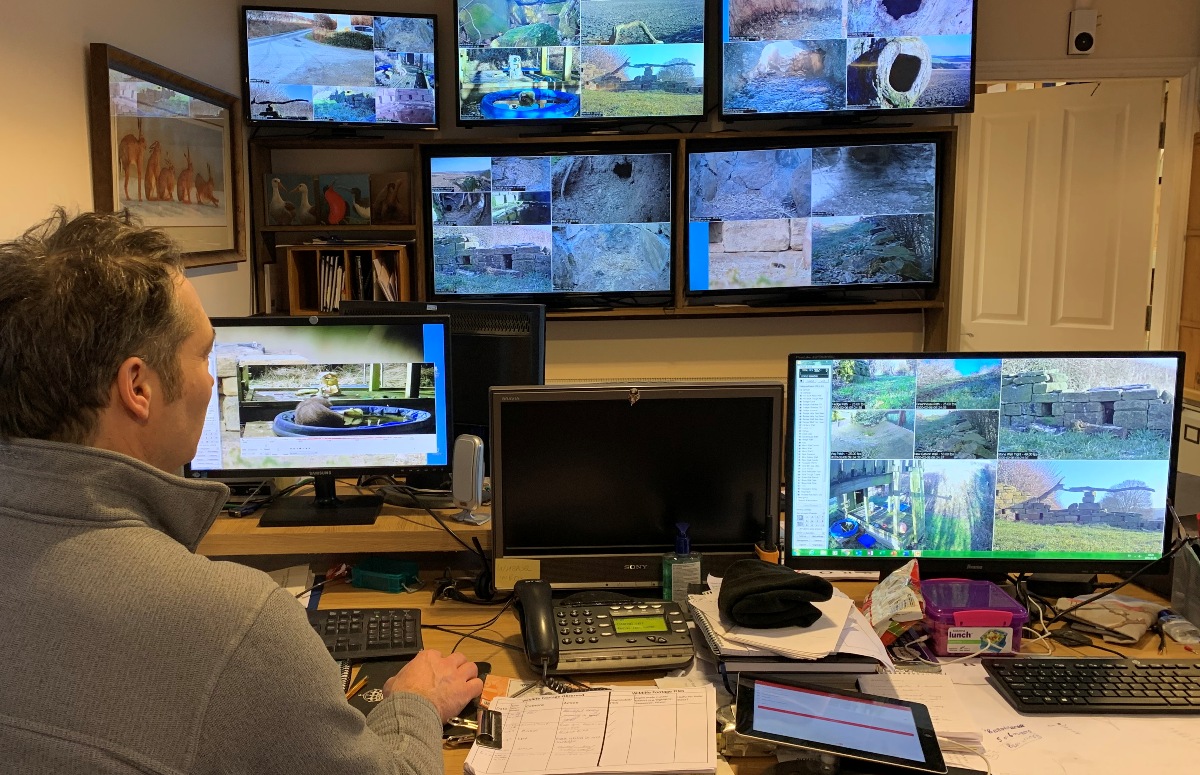
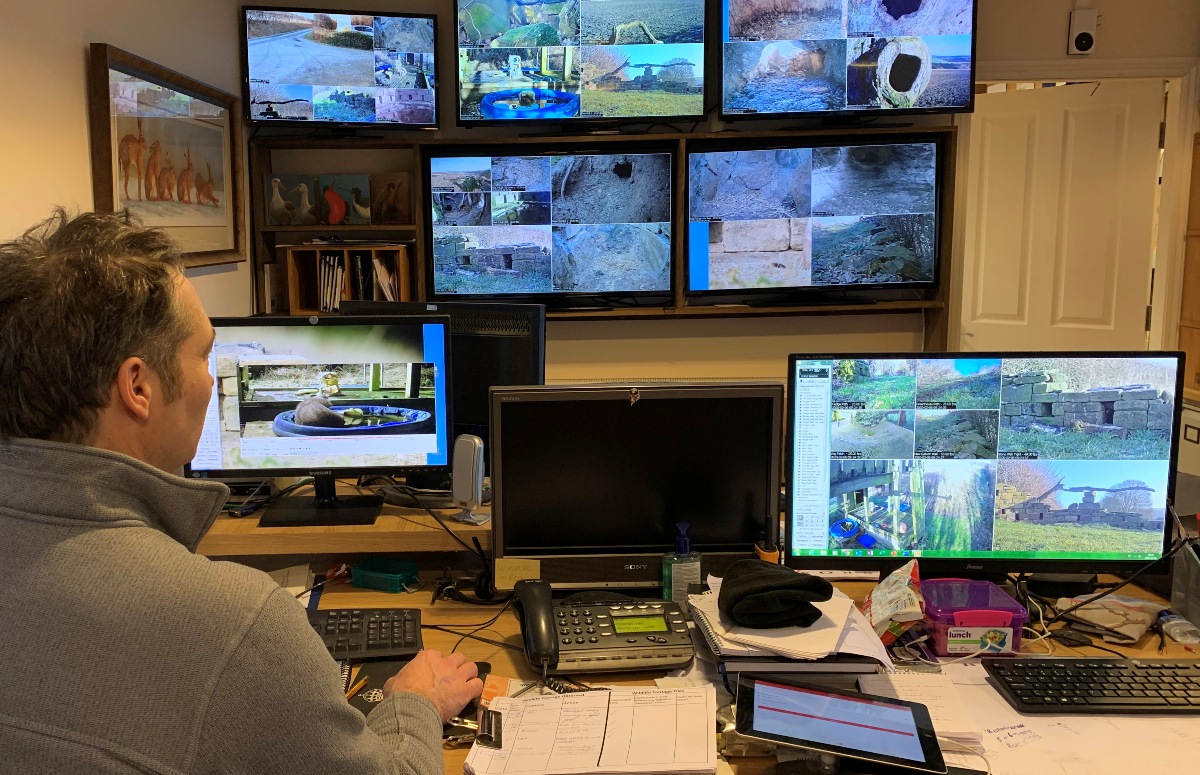
Eight minutes later she ran into her nest on the gabion wall and pulled a kit out by the scruff of its neck. This was the fourth kit. It was now clear she had already moved the other three, fallen kits. But where to? I rushed out into the garden to listen to the birds. Birds are my main allies when I am trying to track a predator. There was a blackbird singing in the front garden, but the bird was clearly relaxed. Then I heard another blackbird by the road call out a warning. It was the sound blackbirds often make when there is a ground predator like a stoat about. Two minutes later a colleague announced on my handheld radio that Bandita was back at the nest taking the fifth kit out. A minute later my colleagues watching the monitors in my office announced she was back again. This time she took food. The timings indicated that it was taking her one minute to get to her new site, and one minute to get back. I estimated that her new location was now 60-70 metres away and the blackbird’s warning had given me a direction.
I now had hunch as to where Bandita could be. I ran inside to get help and then positioned my wife on the road, crouched in the verge, whilst I ran down a field on the other side of the road and my colleague Martyn watched the screens in the control room, as I like to call my office. We each had walkie talkies so that we could relay information instantly. It wasn’t long before a call came through. It was Martyn announcing that Bandita was back at the gabion nest. My heart was pounding, partly from running down the hill and partly wondering what was going to happen next. Then Martyn radioed through to say Bandita was out and she had some food with her. She was heading towards the road. Then my wife called to say Bandita was on the road heading down the hill.
I was perfectly positioned, 90 metres away on the dale side. I spotted Bandita running down the road and into a hedge at the back of a hollow elm tree. She left her food there and set off back to the gabion nest. So now I was sure that she had brought her kits to the hollow elm tree, 70 metres from my garden and more than 110 metres from the control room. I was sorry she hadn’t chosen to use the bin-nest I had constructed for her, but she was now quite close to an older nest I had made from a disused water trough – in fact this was actually the nest she had been born in. I gave her a day to settle in and then deployed a new camera a few metres away from this new site. I also took an old hollow log to the site. I intended to supplement her diet by leaving food for her here. I trained the camera on to this log and was delighted when she took to taking her meals there almost instantly. My main worry now was the danger she faced being so close to the road. This was just two metres away from her new nest.
I happened to know that the local tawny owls liked to roost in the elm tree Bandita had chosen to nest in and I was worried there could be a confrontation and I was right since before long Bandita began chasing these owls as they tried to pinch food from the log. A few days later, clearly fed up with the owls, Bandita was on the move again. Now began my biggest challenge yet. Bandita was taking food from the hollow log by the elm tree and carrying it down the valley. This time there was a seven-minute gap, meaning she could be as much as 350 metres away from the elm tree and 450 metres from the house.
I was really worried that after all this work I was going to lose Bandita and the chance to film a mother stoat with her kits would be lost. Every time I went to track her down, I lost her. If I waited for her in the field, she would run down the road and if I waited on the road at the bottom of the hill she would run down the field using a thick hedge as cover. I decided to cut a path through the long grass in the field for her with my strimmer. I hoped she would use this route instead of the road, where she was at risk of being run over. Then, when she appeared in the garden for food I drove down the hill and waited for her to return so that I could see where she was now hiding. I spotted her a few minutes later running down the new path towards me. Then she bobbed into a hedge right next to the road. I waited. A few seconds later she was out again and off up the hill. Seven minutes later she was back again, darting into the same spot under the hedge. There were a few old rabbit holes under the hedge and so I deployed more cameras on to the track, adding go-pros and a trail camera. I then laid 500 metres of cable to connect a new camera to the system in the control room so we could relay live images from her new site to the office.
I now placed a new feeding box at this location and connected a new camera to it. I then dug the box into the ground so that it would mimic a rabbit hole. This new camera was 25 metres away from her nest. It was crucial not to disturb Bandita whilst we installed the new cable. I didn’t want her to retreat any further away from the house as I was now at the limits of the reach of the technology I had available to relay live images back to base. Everything was working well and at last we were getting really good footage of Bandita, but there was still no sign of the kits. She continued to make regular trips up to the garden each morning and evening, but she was never satisfied and didn’t stay in one place for very long. And then, inevitably, she moved again. This time she took her kits 100 metres further down the valley and out of range. At this point, I decided not to follow her, or to go near her nest.
She was now based at a spot where four valleys meet. I knew this spot to be a prime hunting ground for stoats and suspected that the competition for food here would be acute so I made the bold move of stopping all her supplementary food. Instead, I began to leave food back at the elm tree, 350 metres back towards the house. I hoped she would be tempted back to the garden and, after a few days, my ploy worked. She moved the kits back up the valley, in an old rat hole right opposite the drive to my house. She had given me the real run around over the last few weeks, but I was quite pleased that I had been able to use my camera systems, fieldcraft – and a lot of luck – to keep tabs on her throughout each twist and turn.
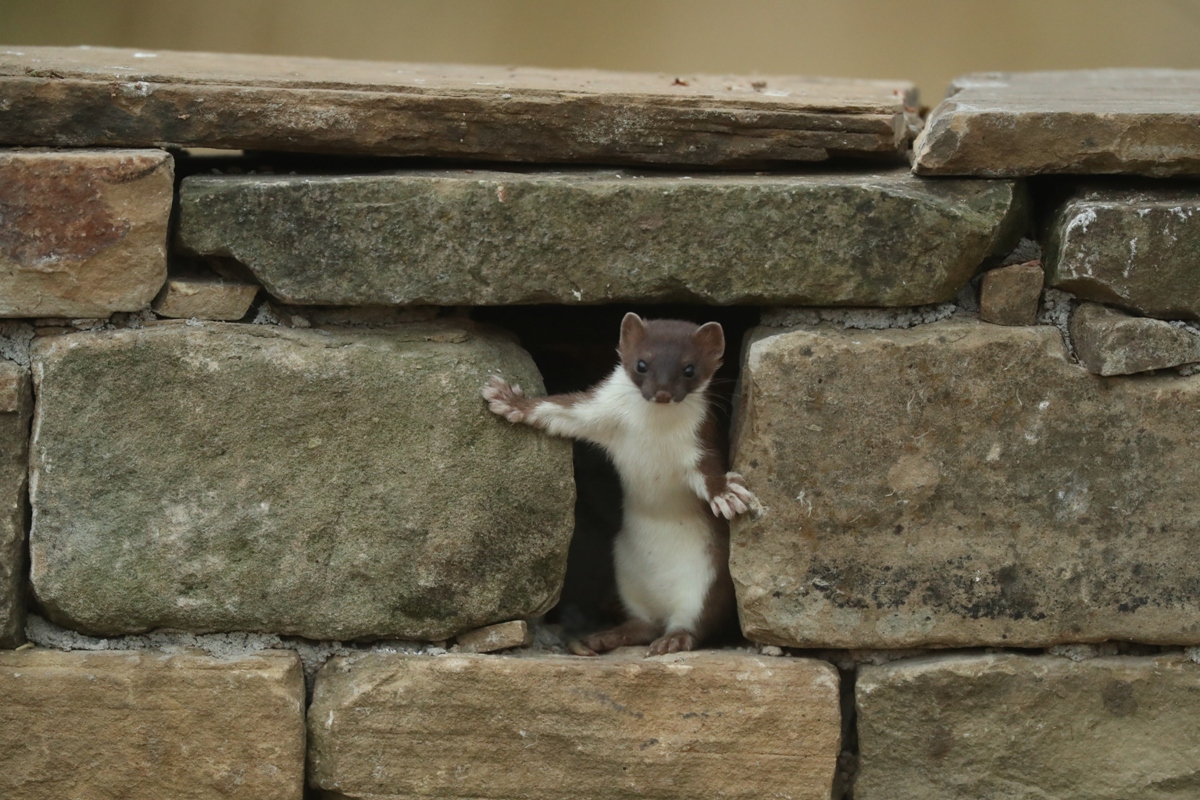
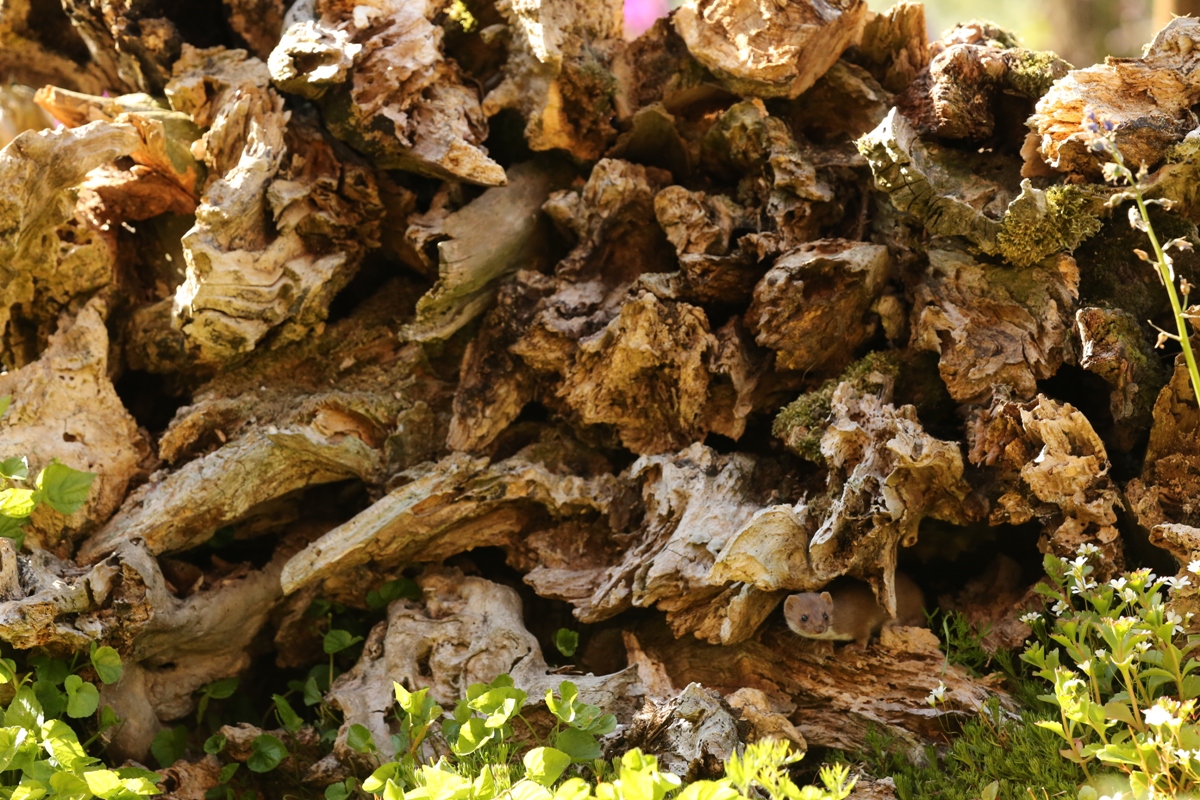
If the game of tracking Bandita had been a football match, the score at this point would have been 3:1 to her, since I had only had a few glimpses of the kits on camera in all this time. And I was yet to see one with my own eyes. Stoats are crafty. They have to be to survive. But Bandita had been almost impossible to keep up with and to film. She was so elusive that at times as I tried to track her it felt like I was trying to track down some mythical creature. I had equal measures of respect and frustration for her. Then the day came when I had just finished feeding the birds in the garden and was in my hide when I noticed the cameras hidden inside the bin looked different. There was a pale patch in the middle of the bedding. I looked at it for a while but there was no movement. I couldn’t work what it was on the small monitor in the hide so I went into the control room to look at it on a bigger screen.
And there it was. A pale, grey stoat kit. YES! I couldn’t resist a fist pump into the air. I had done it. But where were the others? I replayed the footage from the camera trained on the entrance to the nest and there was Bandita going in early that morning with her kits. I counted five. Remarkably they were all still alive after being moved eight times in as many weeks. It turned out that the others were sleeping in the pipes leading to the nest. They would occasionally appear at the nest entrance or in the nest itself, full of mischief and fun and now very cute. Bandita was still a bit suspicious of this nesting chamber and she pulled all the bedding I had left there into the pipework and relocated her nest into these pipes instead of using the nest chamber. I suspect there was just enough room in the junction between the pipes.
Luckily the kits used the bin nest as a place to play and sometimes sleep in and so over the following three days we were able to watch them romping, chasing and pouncing together in here.


One of kits was significantly smaller than the rest and was clearly the runt of the litter. On the 13th June we noticed this kit was in trouble. It was very lethargic and its breathing was laboured. It was also painfully thin and all it seemed to want to do was sleep. We watched as a much larger male kit came in. The runt woke up momentarily to greet it, before slumping back down and curling up. The larger kit, wanting to play, began pouncing on the little runt, biting and scrabbling at it. The helpless kit was just a quarter the other’s weight and just turned away, trying to tuck its his head out of the way. But its larger sibling was relentless and pulled it around by its nose. This must have been excruciatingly painful. It was hard to watch since it was obvious that the smaller kit was not going to make it. It looked like all it wanted to do was curl up and die.
Then Bandita popped her head in and called both of the kits out. This was the last time we saw the little runt kit and I can only assume that it didn’t survive the night. Despite this tragic loss, it was fabulous to have the other kits finally in view. They didn’t use the nest to sleep in that much but they continued to use it as a playground. One cheeky kit didn’t seem to like the fact that Bandita had taken all the bedding into the pipework and we noticed it pulling some back into the bin-nest. But Bandita didn’t approve of this arrangement and two hours later she pointedly took the bedding back into the pipework.
But then, in true Bandita style, she was on the move yet again. This time she headed back to the front garden. Luckily I still had cameras positioned here and over the following four days we had occasional glimpses of the kits. It was incredible that they were now just a few metres away from where they were born. And then, frustratingly, she moved the family yet again. This time our roadside camera picked her up crossing the road. She ran across and was quickly followed by a kit, then a second kit bounded across to join them. Bandita greeted them in turn then looked back as though expecting a third kit to cross. But when it didn’t appear she turned back and dashed into the verge, closely followed by the two kits.
I later discovered that she had left one kit behind. She was away for a few days and during this time I occasionally spotted this lone kit on the cameras and so I left food out for it. It took us a while to locate Bandita again and it turned out she had moved the two kits to an old rabbit hole in the bottom of the valley. On the third day, I woke at 4.40am and noticed Bandita on a camera in the garden with her kits. I drove 550 metres down the road to tell one of the TV cameramen here filming Bandita for the documentary where she was. He told me he had seen her just 15 minutes beforehand. The football game had now reached a score of 3:2. And I had a feeling we might end the whole match with a penalty shoot-out.
Find out what happened to Bandita after the filming was over:
https://www.robertefuller.com/what-happened-to-bandita-the-weasel-after-starring-on-tv/
More on how I built a weasel town to paint weasels
Read my blog post about watching stoat kits at play in the garden:
https://www.robertefuller.com/behind-the-scenes-of-a-tv-weasel-film-stoat-kits-at-play/
Read about how I built Stoat City
None found
Sign up to my newsletter for updates on news, wildlife sightings, products and more directly to your inbox
AS SEEN IN





THE ROBERT FULLER GALLERY
FOTHERDALE FARM
THIXENDALE, MALTON
YO17 9LS
UNITED KINGDOM
TEL: +44 (0) 1759 368355
EMAIL: mail@robertefuller.com
8 Responses
Fascinating reading and I can appreciate that it was such hard work to keep tabs on her. Well done Robert and thanks for a superb account, photographs and your art which hangs on my wall after my visit to your gallery.
Zaf
You are very welcome! Thank you